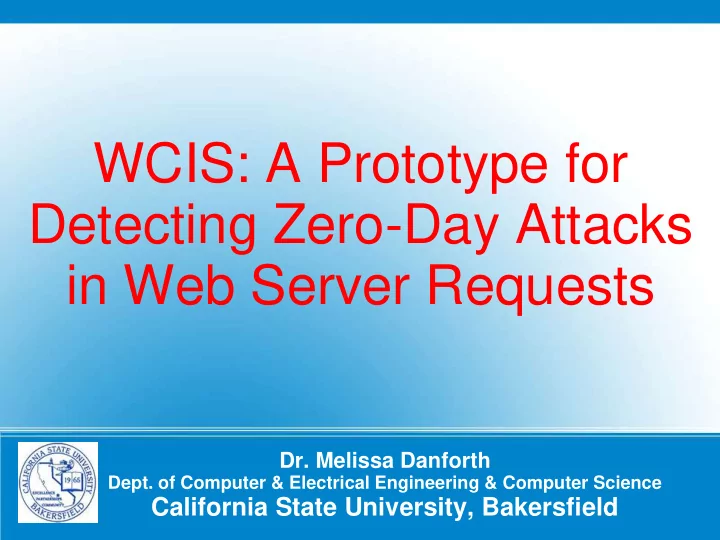

WCIS: A Prototype for Detecting Zero-Day Attacks in Web Server Requests Dr. Melissa Danforth Dept. of Computer & Electrical Engineering & Computer Science California State University, Bakersfield
Presentation Outline Web Classifying Immune System (WCIS) Traditional Artificial Immune System (AIS) features Differences from traditional AIS Classification Scheme Web Server Request Model Population Lifecycle Experimental Results Accuracy at detect attacks in specific classifications Detection of unknown attacks Future Research Dr. Melissa Danforth Dept. of Computer & Electrical Engineering & Computer Science California State University, Bakersfield
Web Classifying Immune System (WCIS) Dr. Melissa Danforth Dept. of Computer & Electrical Engineering & Computer Science California State University, Bakersfield
Artificial Immune System (AIS) Inspired by biological immune systems Ability to adapt to variants and new pathogens Pattern matching for “antibody” and “antigen” binding AIS tries to distinguish “self” from “non - self” “Self” is “normal” traffic, “non - self” is “abnormal” traffic Uses several key biological features Negative selection Affinity maturation Immunization Peripheral tolerance Dr. Melissa Danforth Dept. of Computer & Electrical Engineering & Computer Science California State University, Bakersfield
Web Classifying Immune System (WCIS) Differences from Traditional AIS Add classifications to ‘non - self’ patterns Enables specialization of sensors for specific areas Enables “inoculation” for specific attack class(es) Provides more information about zero-day attack than just “an attack has been detected” Separate evolutionary process from detection Do costly processes “offline” on back -end system Live traffic detection collects statistics to enable further refinement by back-end system Dr. Melissa Danforth Dept. of Computer & Electrical Engineering & Computer Science California State University, Bakersfield
WCIS – Request Classifications Class Description Info Gather information about server Traversal Read-only directory traversal SQL SQL injection attack Buffer Buffer overflow attack Script Execute a script on the webserver XSS Cross-site scripting Dr. Melissa Danforth Dept. of Computer & Electrical Engineering & Computer Science California State University, Bakersfield
WCIS – Request Fingerprint Characteristics of Request HTTP Version + HTTP Command .. Number of Variables \ Length of URI ( or ) % < or > ` // Dr. Melissa Danforth Dept. of Computer & Electrical Engineering & Computer Science California State University, Bakersfield
WCIS – Request Parsing Pattern/chromosome structure Contains full set of request fingerprint features Flags indicate active/inactive features for sensor Each sensor has at least two active features Example: Length of 50-75 characters and 5-10 + characters Pattern matching Sensor compares active features to request Detects request as attack when sensor matches Must fall within range for ranged features Must match set bit for bitmap features Example: Length 65 with 7 + characters Dr. Melissa Danforth Dept. of Computer & Electrical Engineering & Computer Science California State University, Bakersfield
WCIS – Sensor Population Lifecycle Random generation of sensors Select features randomly & initialize with random values Iterative affinity maturation Perform negative selection Test against attacks in population’s classification Breed sensors with best affinity using genetic algorithm Single point crossover and rank selection with elitism Children feature selection based on union of parents’ active features and random active features from each parent Mutate subset of new sensors Select random feature and alter it Dr. Melissa Danforth Dept. of Computer & Electrical Engineering & Computer Science California State University, Bakersfield
WCIS – Sensor Population Lifecycle Deploy sensors on live environment Currently just test sensors against unlabeled data Record accuracy at detection and false positives Compare classification decisions by sensor populations Refine sensors in response to live detection Export statistical information to back-end system Enter a modified affinity maturation loop Code supports concept, but untested due to red tape Received clearance to test live deployment and refinement during this academic term Dr. Melissa Danforth Dept. of Computer & Electrical Engineering & Computer Science California State University, Bakersfield
Experimental Results Dr. Melissa Danforth Dept. of Computer & Electrical Engineering & Computer Science California State University, Bakersfield
Results – Experimental Setup “Normal” dataset – 52977 requests Web server requests from DARPA Lincoln Labs logs Verified normal requests from live web server logs “Attack” dataset – 179 attacks Buqtraq proof of concepts Verified attacks from live web server logs Logs of tests run on isolated machine “Unknown” dataset – 11659 requests Random entries from Apache access.log repository for the department web server Dr. Melissa Danforth Dept. of Computer & Electrical Engineering & Computer Science California State University, Bakersfield
Results – Experimental Setup Variable Description Pop Population size for each classification Gen Max iterations for affinity maturation Xover Percent selected as parents by GA Mut Mutation rate for population Thresh Threshold affinity for negative select. Agree Attack alert agreement threshold Dr. Melissa Danforth Dept. of Computer & Electrical Engineering & Computer Science California State University, Bakersfield
Results – Classification Accuracy Pop=25 Gen=40 Mut=1% Dr. Melissa Danforth Dept. of Computer & Electrical Engineering & Computer Science California State University, Bakersfield
Results – Classification Accuracy Pop=50 Gen=10 Mut=2.5% Dr. Melissa Danforth Dept. of Computer & Electrical Engineering & Computer Science California State University, Bakersfield
Results – Classification Accuracy Pop=75 Gen=20 Mut=5% Dr. Melissa Danforth Dept. of Computer & Electrical Engineering & Computer Science California State University, Bakersfield
Results – Unknown Attacks Detected Class URI Traversal /.php?index=../../../../proc/self/environ%00 Script /*.php?option=com_dump&controller=..//..// ..//..//..//..///proc/self/environ%0000 Traversal Same as previous line Script /faculty/interests/..\\index.html Script /cs150/index.php?p=../../ /…/ports_labeled.jpg Script Dr. Melissa Danforth Dept. of Computer & Electrical Engineering & Computer Science California State University, Bakersfield
Future Research Dr. Melissa Danforth Dept. of Computer & Electrical Engineering & Computer Science California State University, Bakersfield
Future Research Detection against modeled data (real-time) Isolated network is now functional Detection against live data – clearance received Expand fingerprint to include other parts of request Attack data can be in other fields in request Explore other genetic algorithms Single objective algorithm may not be best Try multi-objective algorithms Try variations on genetic algorithms Investigate other networking problem domains Dr. Melissa Danforth Dept. of Computer & Electrical Engineering & Computer Science California State University, Bakersfield
Questions? Dr. Melissa Danforth Dept. of Computer & Electrical Engineering & Computer Science California State University, Bakersfield
Recommend
More recommend